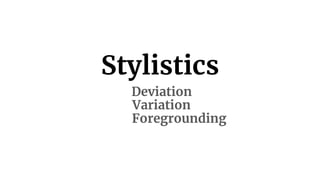
Stylistics: Style as Deviation, Variation and Foregrounding
- 2. Important Views On Style In linguistics, style is associated with characteristics or particular ways of language use. The study of style has a long history. As part of a discipline, style was first presumably involved in classical rhetoric (McArthur, 1992), the art of good speaking in the time of Aristotle. Style in classical rhetoric is mainly concerned with how the arguments in persuasion or public speaking can be dressed up into effective language. With the passage of time, the term “style” has been associated with many different meanings. Style may refer to the language habits of one person (Shakespeare’s style) or of a group of people at a given time (the eighteenth century style). It may also refer to the characteristics of language use in a particular genre (style of advertising discourse). Sometimes, style refers to the effectiveness of language use (lucid style, plain style, pompous style). As a result of these different interpretations, stylisticians have come up with many different views and definitions. In conducting stylistic analysis, the same text can be analyzed in different ways because stylisticians may hold different views on style. These different views determine how a text is analyzed especially what aspects of the text will be the focus of analysis. Thus, we can summarize the mainstream views on style as the conceptual frameworks for stylistic analysis.
- 3. Style as Deviation According to this view, style is regarded as deviation or deviance, i.e. departure from what is normal. The phrase a grief ago from a poem by Dylan Thomas is a good example. Generally, we use a noun indicating time in the expression “a ... ago”, such as a moment ago, a month ago, and the word to fill the slot is normally a countable noun. In this phrase, grief does not meet the conventional requirement. However, as it occurs in a poem, where a novel expression is allowed, it is acceptable. Besides, it expresses an idea in a beautifully succinct way. Since grief means a feeling of great sadness, and any feeling has to last for some time, it is not difficult to figure out the message. That is, something terribly sad has happened, and the speaker of the poem may have experienced grief repeatedly so that he can measure time in terms of it. As the phrase a grief ago represents a special twist on the conventional expression “a ... ago”, it will leave a deep impression on the reader. Such departure is doubtless delightful, but the view of style as deviation tends to undervalue all non-deviant language.
- 4. Style as Variation This view implies the concept of “style as variation”. That is, style consists of saying the same thing in different ways. Here are five sentences roughly conveying the same message: (1) Smokers are requested to occupy rear seats. (2) Smokers please sit at the back. (3) If you smoke, sit at the back. (4) Smokers must sit at the back. (5) Smokers at the back. Since there are different ways of saying the same thing, the key to language use is to make the best choice. Thus, a speaker or writer consistently chooses certain words or structures over others available in the language system. The view that style is choice is a broader view. It may in some way subsume the view of style as deviance, for deviance is only one aspect of the language of literature (Traugott & Pratt, 1980).
- 5. Style as Foregrounding The view of style as foregrounding appears to be a compromise between the two views discussed above. According to this view, style consists of choices of both the deviant features and those linguistic phenomena which are not deviant, but nevertheless striking. This view emphasizes two major types of choices, i.e. choices that are deviant and those that are over-regular, for they both produce foregrounding. Deviation produces foregrounding by breaking the rules or norms of everyday language. Overregularity produces foregrounding by means of uniformity of choice within the language system (e.g. Rhythmic patterns, rhyming patterns and parallelism) in order to draw readers attention. Deviation can occur at all levels of language: phonological, graphological, lexical, syntactic, semantic and textual, whereas over-regularity exists mainly at the phonological and syntactic levels of language.